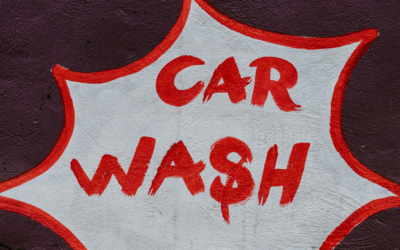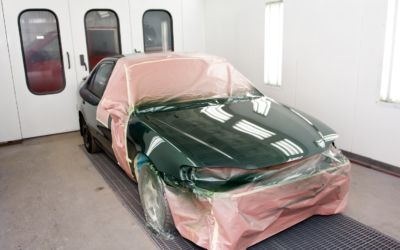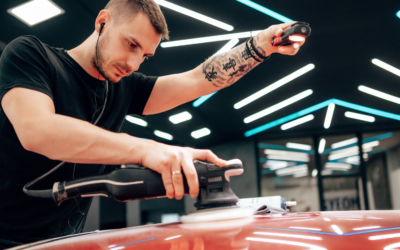Your car seats endure a lot. From daily commutes to weekend road trips, spilled coffee to muddy shoes, they face constant challenges that can leave them looking worn and grimy. Learning how to clean car seats properly not only keeps your vehicle looking fresh but also extends the life of your upholstery and maintains your car’s resale value.
Whether you’re dealing with leather car seats or fabric seats, tough stains or routine maintenance, this comprehensive guide will walk you through everything you need to know about cleaning car seats. We’ll cover the right cleaning products, techniques for different materials, and professional tips to help you achieve that new car seat appearance.
The key to successful car seat cleaning lies in understanding your specific car seat material and using the appropriate methods. Let’s dive into the step-by-step process that will transform your car’s interior.
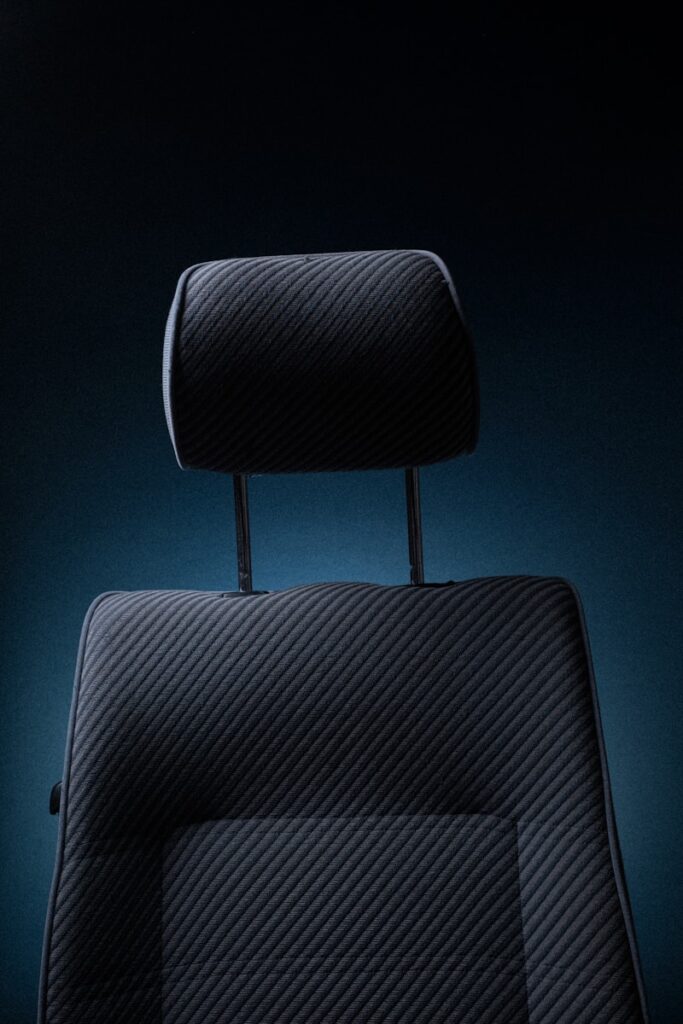
Photo by Kajetan Powolny on Unsplash
Understanding Your Car Seat Material
Before you begin cleaning, identify what type of seats your vehicle has. This crucial first step determines which cleaning products and techniques you’ll use.
Car Seat Fabric
Most vehicles come with fabric seats, which can range from basic cloth to more delicate fabrics. Car seat fabric is generally durable, but different weaves and treatments require specific care approaches. Check your vehicle’s manual or look for care labels to identify any special requirements for your car’s fabric seats.
Leather Car Seats
Leather upholstery adds luxury to your vehicle but requires gentle handling. Real leather needs special attention to prevent cracking, fading, or damage from harsh chemicals. Always test any cleaning solution on an inconspicuous area first when working with leather car seats.
Mixed Materials
Some vehicles feature combination upholstery with leather on seating surfaces and fabric or vinyl on sides and backs. Each material will need its own specific cleaning approach during the same session.
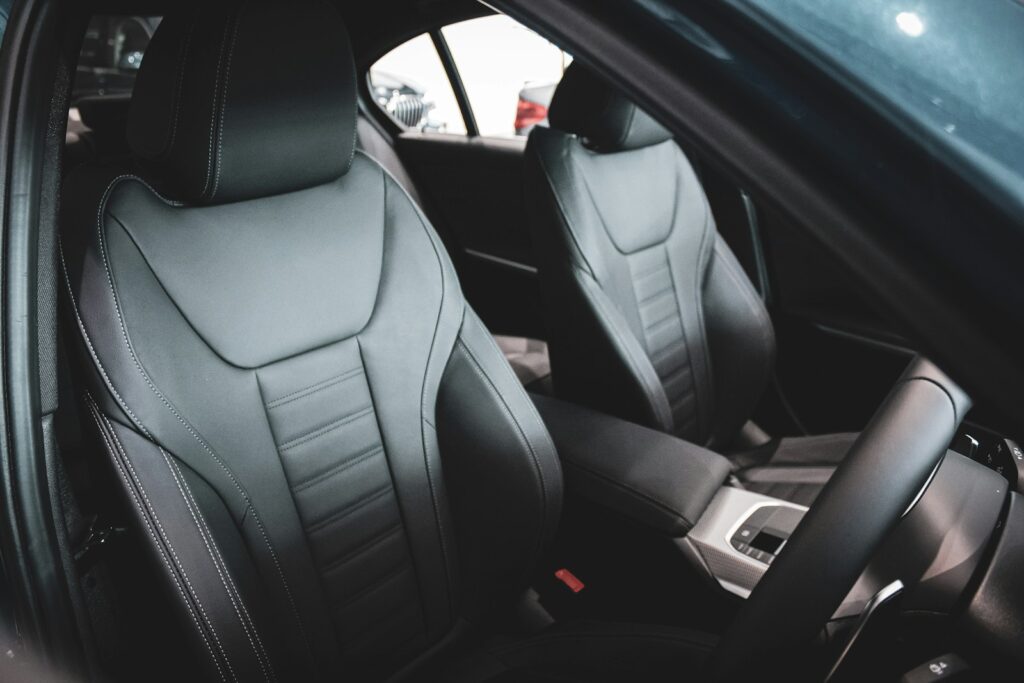
Photo by Haryo Ramadantyo on Unsplash
Essential Cleaning Supplies and Tools
Gathering the right supplies before you start makes the cleaning process more efficient and effective. Here’s what you’ll need:
Basic Cleaning Tools
Start with a good vacuum cleaner with a brush attachment. A soft bristled brush helps loosen dirt without damaging fabric, while a microfiber towel provides lint-free cleaning and drying. For deeper cleaning, consider a steam cleaning device, which can sanitize and remove stubborn stains without harsh chemicals.
Cleaning Solutions
For fabric seats, mild detergent mixed with cold water works well for general cleaning. White vinegar mixed with warm water creates an effective, plant based solution for odor removal. Avoid bleach or harsh cleaners that can damage fabric fibers or cause discoloration.
For leather car seats, use a dedicated leather cleaner followed by leather conditioner to keep the material supple. Never use products containing alcohol or ammonia on leather, as these can cause cracking and permanent damage.
Specialty Items
Keep rubbing alcohol on hand for sanitizing, but use it sparingly and only on appropriate materials. A damp cloth is essential for wiping down surfaces, and having both cold water and warm water available gives you flexibility for different cleaning tasks.
Preparing Your Car for Cleaning
Proper preparation sets the stage for effective cleaning and prevents damage to your vehicle’s interior.
Remove All Items
Clear out everything from your car seats and surrounding areas. Check seat pockets, under seats, and between cushions. Remove floor mats and any seat covers to access all surfaces that need cleaning.
Initial Vacuuming
Use your vacuum’s brush attachment to remove loose dirt from all surfaces. Pay special attention to crevices where crumbs and debris accumulate. This step prevents dirt from turning into mud when you apply cleaning solutions.
Work systematically, starting from the top of each seat and moving down. Don’t forget the back of seats, sides, and any accessible areas underneath. Remove loose dirt thoroughly before moving to wet cleaning methods.
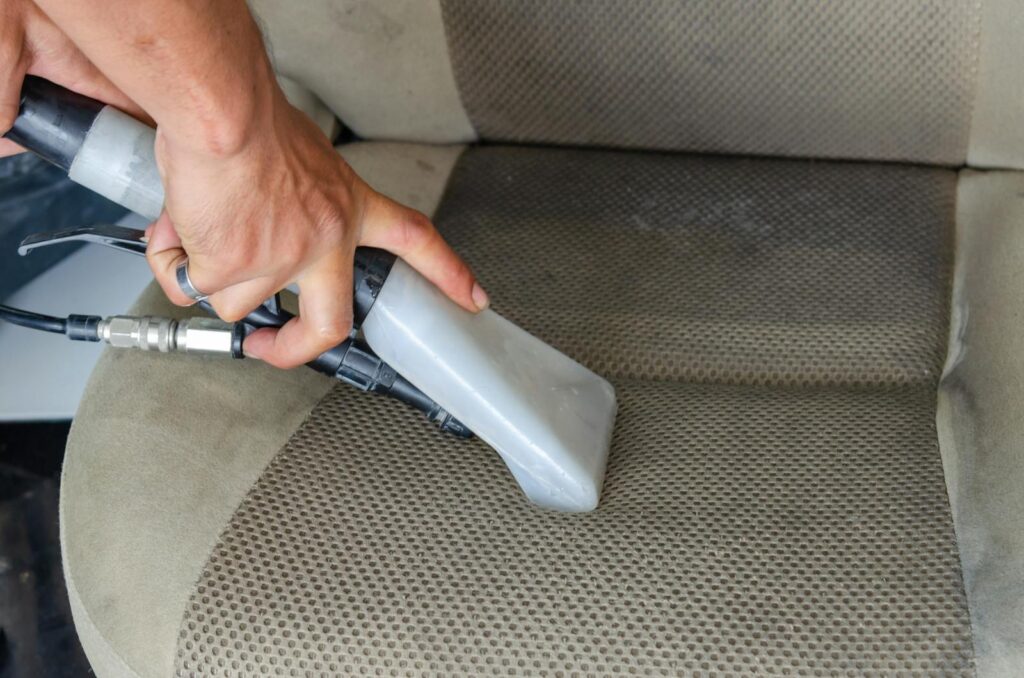
Photo by Khunkorn Laowisit on Pexels
Cleaning Fabric Car Seats
Fabric seats are generally more forgiving than leather, but they still require proper technique to avoid damage or spreading stains.
Spot Cleaning Techniques
Address stains immediately for best results. Create a cleaning solution using mild soap and cold water. Test the mixture on an inconspicuous area first to ensure it won’t cause discoloration or damage.
Apply the solution sparingly to avoid oversaturating the fabric. Use a soft bristled brush in circular motions to work the cleaner into the stain. Avoid scrubbing too aggressively, which can damage delicate fabrics or spread the stain.
For stubborn stains, let the cleaning solution sit for a few minutes before gently working it with your brush. Protein-based stains like blood or food may require enzyme-based cleaners for complete removal.
Deep Cleaning Process
For overall cleaning, work in sections to prevent the cleaning solution from drying before you can properly rinse it. Mix your mild detergent with warm water, but avoid using too much soap, which can leave residue.
Apply the solution with a damp cloth, working it into the fabric with gentle circular motions. Use a clean, damp cloth to remove soap residue, then follow with a dry microfiber towel to absorb excess moisture.
Steam cleaning provides the deepest clean for fabric seats. The high temperature sanitizes while loosening embedded dirt and grime. Always follow your steam cleaner’s product instructions and allow adequate drying time.
Drying and Finishing
Proper drying prevents mold and mildew growth. Leave car doors and windows open to promote air circulation. Avoid direct sunlight, which can fade fabric colors or cause uneven drying patterns.
For removable seat covers that can machine wash, use cold water and a gentle cycle. Check care labels first, as some materials may require special handling. Tumble dry on low heat only if the care instructions permit.
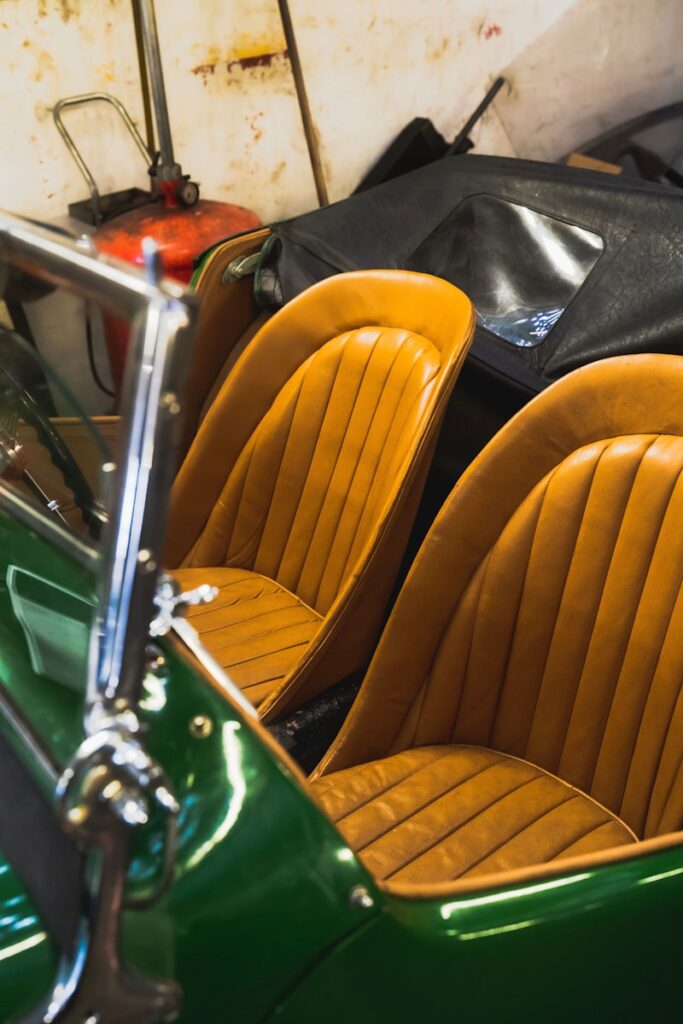
Photo by Matthieu Beaumont on Unsplash
Cleaning Leather Car Seats
Leather requires a more delicate approach than fabric, but with proper care, it can last for decades while maintaining its luxurious appearance.
Gentle Cleaning Approach
Start by vacuuming loose dirt and debris using a soft brush attachment. Be gentle around seams and perforated areas where the leather might be more delicate.
Create a cleaning solution using products specifically designed for leather, or make your own with a small amount of mild soap and cold water. The solution should be barely soapy – too much soap can damage leather fibers.
Application Technique
Apply cleaner with a damp cloth, working in small sections. Use circular motions with light pressure, allowing the cleaner to lift dirt without oversaturating the leather. Immediately follow with a clean, slightly damp cloth to remove cleaning residue.
Pay special attention to high-wear areas like the driver’s seat bolster and armrests, where body oils and dirt accumulate most heavily. These areas may need extra attention but avoid excessive scrubbing.
Conditioning and Protection
After cleaning, apply leather conditioner to keep the material supple and prevent cracking. Quality conditioner also provides protection against UV damage and future stains.
Apply conditioner with a clean microfiber towel, working it into the leather in thin, even coats. Allow it to penetrate for the time specified in the product instructions, then buff away any excess with a dry cloth.
Tackling Tough Stains and Specific Issues
Some stains require specialized approaches beyond basic cleaning methods.
Grease and Oil Stains
For fresh grease stains, immediately blot with a clean cloth to absorb as much as possible without spreading the stain. Avoid rubbing, which pushes the grease deeper into fibers.
Apply a small amount of mild detergent directly to the stain and let it sit for several minutes. Work it gently with a soft brush, then rinse with cold water and blot dry.
Food and Beverage Spills
Act quickly with liquid spills by blotting up excess moisture. For sticky substances like soda or juice, clean with cold water first to prevent the sugars from setting into the fabric.
Coffee stains often require multiple treatments. Start with cold water, then progress to mild detergent if needed. For set-in coffee stains on fabric, white vinegar mixed with cold water can help break down the tannins.
Ink and Marker Stains
Rubbing alcohol can be effective on ink stains, but test it on an inconspicuous area first. Apply small amounts with a cotton swab, working from the outside of the stain inward to prevent spreading.
Mold and Mildew
Address mold immediately, as it can spread quickly and create health hazards. Vacuum loose spores with a brush attachment, then clean with a solution of white vinegar and water.
For severe mold issues, professional cleaning may be necessary. Some cases might require replacement parts if the contamination is too extensive.
Professional Cleaning At Fusion Car Wash vs. DIY Cleaning
Understanding when to tackle cleaning yourself and when to call professionals can save time, money, and potential damage.
When DIY Works Best
Regular maintenance cleaning, spot cleaning of fresh stains, and routine care can typically be handled at home. If you have the right supplies and time, DIY cleaning is cost-effective for most situations.
Basic fabric cleaning is usually straightforward for car owners who follow proper techniques. Even leather cleaning can be done at home with appropriate products and care.
When to Choose Professional Cleaning At Fusion Car Wash
Deep-set stains, extensive damage, or delicate fabrics may require professional expertise. Professional cleaners have access to specialized equipment and cleaning solutions that aren’t available to consumers.
Consider professional cleaning for valuable vehicles, classic cars, or when dealing with biohazards like bodily fluids. Professionals also have experience with unusual materials or exotic leathers that might be damaged by improper home cleaning.
Cost Considerations
While professional cleaning costs more upfront, it might be more economical for severe problems that could require multiple DIY attempts. Professional cleaning also typically comes with guarantees on their work.
Maintaining Clean Car Seats
Prevention and regular maintenance keep your car seats looking their best between deep cleaning sessions.
Regular Maintenance Schedule
Vacuum your seats weekly to prevent dirt buildup. Address spills immediately to prevent staining. Monthly spot cleaning of high-use areas helps maintain appearance and hygiene.
For leather seats, apply conditioner every three to six months, or more frequently in harsh climates. This regular care prevents cracking and maintains the leather’s natural oils.
Protective Measures
Consider seat covers for high-use vehicles or when transporting pets and children. Quality covers protect against spills while being easier to clean than the actual upholstery.
Use sunshades to protect leather from UV damage, which can cause fading and cracking over time. Park in shade when possible to minimize heat and sun exposure.
Environmental Factors
Humidity can promote mold growth, while dry conditions can crack leather. Use appropriate climate control and consider moisture absorbers in stored vehicles.
Be mindful of what you bring into your car. Sharp objects can tear fabric or scratch leather, while certain chemicals from gym bags or work equipment might stain or damage upholstery.
Car Seat Cleaning Products and Brands
Chemical Guys Total Interior Cleaner & Protectant
A versatile cleaner safe for upholstery, leather, and other car interior surfaces. It gently removes dirt while providing UV protection.
Meguiar’s Carpet & Upholstery Cleaner
Specially formulated to clean fabric seats and floor mats efficiently, this foam-based cleaner penetrates deep to lift stains and odors.
Leather Honey Leather Cleaner
Ideal for leather car seats, this non-toxic cleaner removes dirt and grime without leaving a residue, keeping leather supple and fresh.
CarGuys Super Cleaner
A multi-surface, no-harsh-chemicals cleaner that works on a variety of materials including dashboard and steering wheel. Its fast-acting formula is perfect for tackling tough stains.
Turtle Wax Power Out! Upholstery Cleaner
Ideal for fabric seats, this product comes with an integrated scrubbing brush cap to assist with deep cleaning and removing tough stains.
Armor All Leather Care Gel
A premium option for leather seats, this gel formula cleans, conditions, and protects against cracking and fading.
303 Fabric Guard
Designed to protect upholstered car seats from stains and liquids, this product is a perfect follow-up after cleaning to maintain cleanliness.
Using the right product will not only make cleaning easier but also help you maintain the condition and longevity of your car seats.

Stop by Fusion Car Wash for a professional clean today!
Transform Your Car’s Interior Today | Cleaning Car Seats
Clean car seats make every drive more enjoyable and help maintain your vehicle’s value. Whether you’re dealing with daily wear, stubborn stains, or just want to refresh your car’s interior, the right approach makes all the difference.
Remember to always test cleaning products in an inconspicuous area first, work systematically, and be patient with the process. Regular maintenance prevents major problems and keeps your car looking and smelling fresh.
For those times when DIY cleaning isn’t enough, don’t hesitate to seek professional help. The investment in proper care pays dividends in comfort, appearance, and resale value. Start with regular vacuuming and spot cleaning, then progress to deeper cleaning methods as needed. Your car seats—and your passengers—will thank you for the extra attention.


